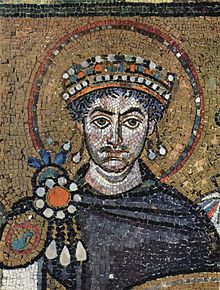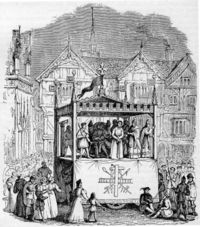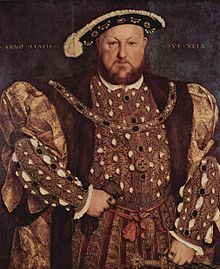- Medieval theatre
-
Greek • Roman • Medieval • Commedia dell'arte • English Renaissance • Spanish Golden Age • Neoclassical • Restoration • Augustan • Weimar • Romanticism • Melodrama •
Naturalism • Realism • Modernism • Postmodern
19th century • 20th century (timeline)Medieval theatre refers to the theatre of Europe between the fall of the Western Roman Empire in the 5th century A.D. and the beginning of the Renaissance in approximately the 15th century A.D. Medieval theatre covers all drama produced in Europe over that thousand year period and refers to a variety of genres, including liturgical drama, mystery plays, morality plays, farces and masques. Beginning with Hrosvitha of Gandersheim in the 10th century, Medieval drama was for the most part very religious and moral in its themes, staging and traditions. The most famous examples of medieval plays are the English cycle dramas, the York Mystery Plays, the Chester Mystery Plays, the Wakefield Mystery Plays and the N-Town Plays, as well as the morality play, Everyman.
Due to a lack of surviving records and texts, a low literacy rate of the general population, and the opposition of the clergy to some types of performance, there are few surviving sources on medieval drama of the early and high medieval periods. However, by the late period, drama and theatre began to become more secularized and a larger number of records survive documenting plays and performances.
Contents
Transition from Rome, 500-900 A.D.
 Justinian I closed all theatres in the 6th century C.E.
Justinian I closed all theatres in the 6th century C.E.
As the Western Roman Empire fell into decay through the 4th and 5th centuries A.D., the seat of Roman power shifted to Constantinople and the Eastern Roman Empire, today called the Byzantine Empire. While surviving evidence about Byzantine theatre is slight, existing records show that mime, pantomime, scenes or recitations from tragedies and comedies, dances, and other entertainments were very popular. Constantinople had two theatres that were in use as late as the 5th century A.D. However, the true importance of the Byzantines in theatrical history is their preservation of many classical Greek texts and the compilation of a massive encyclopedia called the Suda, from which is derived a large amount of contemporary information on Greek theatre.[1] In the 6th century, the Emporer Justinian finally closed down all theatres for good.
According to the binary thinking of the Church's early followers, everything that did not belong to God belonged to the Devil; thus all non-Christian gods and religions were satanic. Efforts were made in many countries through this period to not only convert Jews, pagans and Muslims but to destroy pre-Christian institutions and influences. Works of Greek and Roman literature were burnt, the thousand-year-old Platonic Academy was closed, the Olympic games were banned and all theatres were shut down. The theatre itself was viewed as a diabolical threat to Christianity because of its continued popularity in Rome even among new converts. Church fathers such as Tatian, Tertullian and Augustine characterized the stage as instruments in the devil's fiendish plot to corrupt men's souls, while acting was considered sinful because of it's cruel mockery of God's creation.[2]
Under these influences, the Church set about trying to suppress theatrical spectacles by passing laws prohibiting and excluding Roman actors. They were forbidden to have contact with Christian women, own slaves, or wear gold. They were officially excommunicated, denied the sacraments, including marriage and burial, and were defamed and debased throughout Europe. For many centuries thereafter, clerics were cautioned to not allow these suddenly homeless, travelling actors to perform in their jurisdictions. [2]
From the 5th century, Western Europe was plunged into a period of general disorder that lasted (with a brief period of stability under the Carolingian Empire in the 9th century) until the 10th century A.D. As such, most organized theatrical activities disappeared in Western Europe. While it seems that small nomadic bands traveled around Europe throughout the period, performing wherever they could find an audience, there is no evidence that they produced anything but crude scenes.[3]
Early Medieval Period
Faced with the problem of explaining a new religion to a largely illiterate population, churches in the early Middle Ages began staging dramatized versions of particular biblical events on specific days of the year. These dramatizations were included in order to vivify annual celebrations. [4] Symbolic objects and actions - vestments, altars, censers, and pantomime performed by priests - recalled the events which Christian ritual celebrates. These were extensive sets of visual signs that could be used to communicate with a largely illiterate audience. These performances developed into liturgical dramas, the earliest of which is the Whom do you Seek (Quem-Quaeritis) Easter trope, dating from ca. 925.[5] Liturgical drama was sung responsively by two groups and did not involve actors impersonating characters. However, sometime between 965 and 975, Æthelwold of Winchester composed the Regularis Concordia (Monastic Agreement) which contains a playlet complete with directions for performance.[6]
Hrosvitha (c.935-973), an aristocratic canoness and historian in northern Germany, wrote six plays modeled on Terence's comedies but using religious subjects in the 10th century A.D. Terence's comedies had long been used in monastery schools as examples of spoken Latin but are full of clever, alluring courtesans and ordinary human pursuits such as sex, love and marriage. In order to preempt criticism from the Church, Hrosvitha prefaced her collection by stating that her moral purpose to save Christians from the guilt they must feel when reading Classical literature. Her declared solution was to imitate the "laudable" deeds of women in Terence's plays and discard the "shameless" ones.[7] These six plays are the first known plays composed by a female dramatist and the first identifiable Western dramatic works of the post-classical era.[6] They were first published in 1501 and had considerable influence on religious and didactic plays of the sixteenth century. Hrosvitha was followed by Hildegard of Bingen (d. 1179), a Benedictine abbess, who wrote a Latin musical drama called Ordo Virtutum in 1155.
The anonymous pagan play "Querolus", written c.420, was adapted in the 12th century by Vitalis of Blois. Other secular Latin plays were also written in the 12th century, mainly in France but also in England ("Babio"). There certainly existed some other performances that were not fully fledged theatre; they may have been carryovers from the original pagan cultures (as is known from records written by the clergy disapproving of such festivals). It is also known that mimes, minstrels, bards, storytellers, and jugglers traveled in search of new audiences and financial support. Not much is known about these performers' repertoire and few written texts survive. One of the most famous of the secular plays is the musical "Le Jeu de Robin et Marion", written by Adam de la Halle in the 13th century, which is fully laid out in the original manuscript with lines, musical notation, and illuminations in the margins depicting the actors in motion. Adam also wrote another secular play, "Jeu de la Fueillee" in Arras, a French town in which theatre was thriving in the late 12th and 13th centuries. Perhaps the finest play surviving from Arras, is the "Jeu de saint Nicolas" by Jean Bodel (c.1200).
High and Late Medieval Theatre
As the Viking invasions ceased in the middle of the 11th century A.D., liturgical drama had spread from Russia to Scandinavia to Italy. Only in Muslim-occupied Spain were liturgical dramas not presented at all. Despite the large number of liturgical dramas that have survived from the period, many churches would have only performed one or two per year and a larger number never performed any at all. [8]
The Feast of Fools was especially important in the development of comedy. The festival inverted the status of the lesser clergy and allowed them to ridicule their superiors and the routine of church life. Sometimes plays were staged as part of the occasion and a certain amount of burlesque and comedy crept into these performances. Although comic episodes had to truly wait until the separation of drama from the liturgy, the Feast of Fools undoubtedly had a profound effect on the development of comedy in both religious and secular plays. [9]
Performance of religious plays outside of the church began sometime in the 12th century through a traditionally accepted process of merging shorter liturgical dramas into longer plays which were then translated into vernacular and performed by laymen. The Mystery of Adam (1150) gives credence to this theory as its detailed stage direction suggest that it was staged outdoors. A number of other plays from the period survive, including La Seinte Resurrection (Norman), The Play of the Magi Kings (Spanish), and Sponsus (French).
The importance of the High Middle Ages in the development of theatre was the economic and political changes that led to the formation of guilds and the growth of towns. This would lead to significant changes in the Late Middle Ages. In the British Isles, plays were produced in some 127 different towns during the Middle Ages. These vernacular Mystery plays were written in cycles of a large number of plays: York (48 plays), Chester (24), Wakefield (32) and Unknown (42). A larger number of plays survive from France and Germany in this period and some type of religious dramas were performed in nearly every European country in the Late Middle Ages. Many of these plays contained comedy, devils, villains and clowns.[10]
The majority of actors in these plays were drawn from the local population. For example, at Valenciennes in 1547, more than 100 roles were assigned to 72 actors.[11] Plays were staged on pageant wagon stages, which were platforms mounted on wheels used to move scenery. Often providing their own costumes, amateur performers in England were exclusively male, but other countries had female performers. The platform stage, which was an unidentified space and not a specific locale, allowed for abrupt changes in location.
Morality plays emerged as a distinct dramatic form around 1400 and flourished until 1550. The most interesting morality play is The Castle of Perseverance which depicts mankind's progress from birth to death. However, the most famous morality play and perhaps best known medieval drama is Everyman. Everyman receives Death's summons, struggles to escape and finally resigns himself to necessity. Along the way, he is deserted by Kindred, Goods, and Fellowship - only Good Deeds goes with him to the grave.
There were also a number of secular performances staged in the Middle Ages, the earliest of which is The Play of the Greenwood by Adam de la Halle in 1276. It contains satirical scenes and folk material such as faeries and other supernatural occurrences. Farces also rose dramatically in popularity after the 13th century. The majority of these plays come from France and Germany and are similar in tone and form, emphasizing sex and bodily excretions.[12] The best known playwright of farces is Hans Sachs (1494-1576) who wrote 198 dramatic works. In England, the The Second Shepherds' Play of the Wakefield Cycle is the best known early farce. However, farce did not appear independently in England until the 16th century with the work of John Heywood (1497-1580).
A significant forerunner of the development of Elizabethan drama was the Chambers of Rhetoric in the Low Countries.[13] These societies were concerned with poetry, music and drama and held contests to see which society could compose the best drama in relation to a question posed.
At the end of the Late Middle Ages, professional actors began to appear in England and Europe. Richard III and Henry VII both maintained small companies of professional actors. Their plays were performed in the Great Hall of a nobleman's residence, often with a raised platform at one end for the audience and a "screen" at the other for the actors. Also important were Mummers' plays, performed during the Christmas season, and court masques. These masques were especially popular during the reign of Henry VIII who had a House of Revels built and an Office of Revels established in 1545.[14]
Staging
Depending on the area of the performances, the plays were performed in the middle of the street, on pageant wagons in the streets of great cities (this was inconvenient for the actors because the small stage size made stage movement impossible), in the halls of nobility, or in the round in amphitheatres, as suggested by current archaeology in Cornwall and the southwest of England. All medieval stage production was temporary and expected to be removed upon the completion of the performances. Actors, predominantly male, typically wore long, dark robes. Medieval plays such as the Wakefield cycle, or the Digby Magdalene featured lively interplay between two distinct areas, the wider spaces in front of the raised staging areas, and the elevated areas themselves (called, respectively, the locus and the platea).[15] Typically too, actors would move between these locations in order to suggest scene changes, rather than remain stationary and have the scene change around them as is typically done in modern theater.
Decline and Change
Its death was due mostly to changing political and economic factors. First, the Protestant Reformation targeted the theatre, especially in England, in an effort to stamp out allegiance to Rome. In Wakefield, for example, the local mystery cycle text shows signs of Protestant editing, with references to the pope crossed out and two plays completely eliminated because they were too Catholic. However, it was not just the Protestants who attacked the theatre of the time. The Council of Trent banned religious plays in an attempt to rein in the extrabiblical material that the Protestants frequently lampooned.
A revival of interest in ancient Roman and Greek culture changed the tastes of the learned classes in the performing arts. Greek and Roman plays were performed and new plays were written that were heavily influenced by the classical style. This led to the creation of Commedia dell'arte and other forms of Renaissance theatre.
A change of patronage also caused drastic changes to the theatre. In England the monarch and nobility started to support professional theatre troupes (including Shakespeare's Lord Chamberlain's Men and King's Men), which catered to their upper class patron's tastes. These patrons desired to be entertained, not preached to, and as time passed the plays became more secular and refined. In time these same tastes would filter down to the lower classes.
Finally, the construction of permanent theaters, such as the Blackfriars Theatre signaled a major turning point from reliance on church facilities, touring groups, and inns as stages. Permanent theaters allowed for more sophisticated staging and storytelling. Moreover, professional troupes that owned their own theatre had more resources with which to prepare their productions, which changed the theatre from a mostly amateur or traveling art form to a professional one with different practices and standards.
Contributions to Theatre
See also
Notes
- ^ Brockett and Hildy (2003, 70)
- ^ a b Wise and Walker (2003, 184)
- ^ Brockett and Hildy (2003, 75)
- ^ Brockett and Hildy (2003, 76)
- ^ Ibid.
- ^ a b Brockett and Hildy (2003, 77)
- ^ Wise and Walker (2003, 190)
- ^ Brockett and Hildy (2003, 78)
- ^ Brockett and Hildy (2003, 81)
- ^ Brockett and Hildy (2003, 86)
- ^ Brockett and Hildy (2003, 95)
- ^ Brockett and Hildy (2003, 96)
- ^ Brockett and Hildy (2003, 99)
- ^ Brockett and Hildy (2003, 101-103)
- ^ Dillon, Cambridge Introduction to Early English Theatre (Cambridge: CUP, 2006), pp4-16.
References
- Bate, Keith, ed. 1976. Three Latin Comedies. Toronto, Cantre for Medieval Studies.
- Brockett, Oscar G. and Franklin J. Hildy. 2003. History of the Theatre. Ninth edition, International edition. Boston: Allyn and Bacon. ISBN 0205410502.
- Cohen, Robert. 2000. Theatre: Brief Edition. Mayfield Publishing Company, p. 201-203.
- Nelson, Alan H. 1972. "Some Configurations of Staging in Medieval English Drama" Medieval English Drama: Essays Critical and Contextual University of Chicago Press, p. 116-147.
- Symes, Carol, 2007. A Common Stage: Theatre and Public Life in Medieval Arras. Cornell University Press.
- Walsh, Martin. 2002. "Drama." Medieval Folklore: A Guide to Myths, Legends, Tales, Beliefs, and Custons. Oxford University Press, p. 103-107.
- Wise, Jennifer and Craig S. Walker, eds. 2003. The Broadview Anthology of Drama: Plays from the Western Theatre, Volume 1. Toronto: Braodview Press Ltd.
Tudor Moralities and Interludes 
Interludes 
Related works Medieval theatre · Psychomachia · Autos sacramentales · Ordo Virtutum · Elckerlijc · A Satire of the Three Estates · A Looking Glass for London · Four Plays in One · Pathomachia · The Sun's DarlingCharacters Categories:- History of theatre
- Medieval drama
- Medieval literature
- Theatrical genres
Wikimedia Foundation. 2010.





